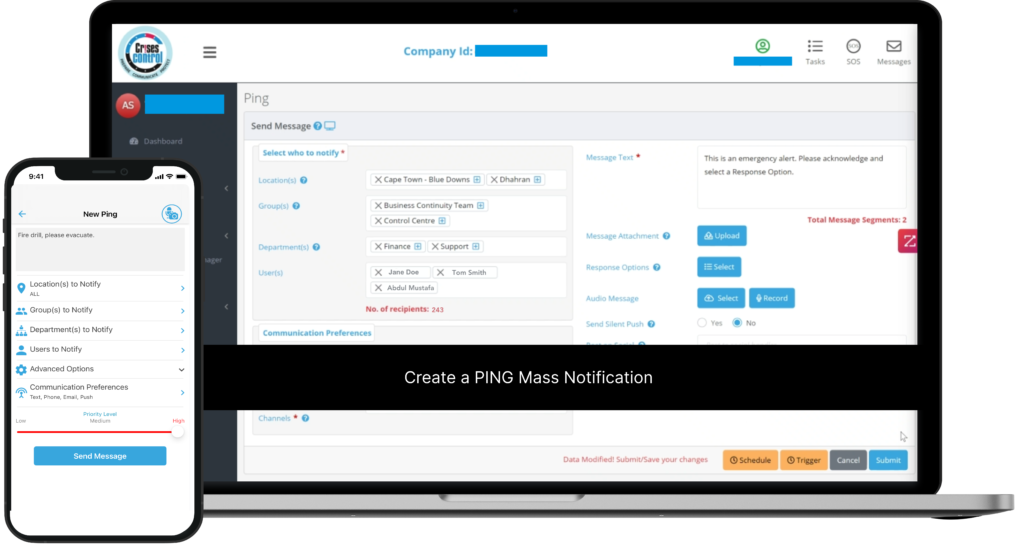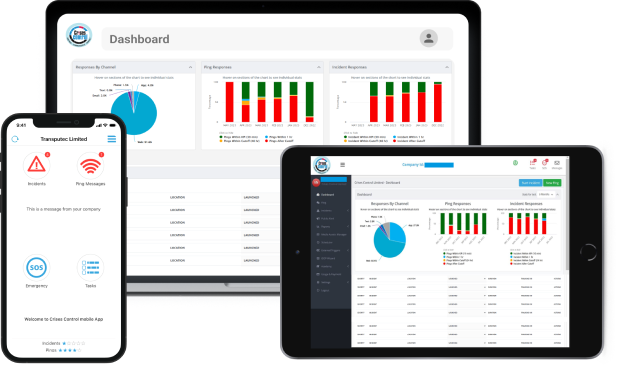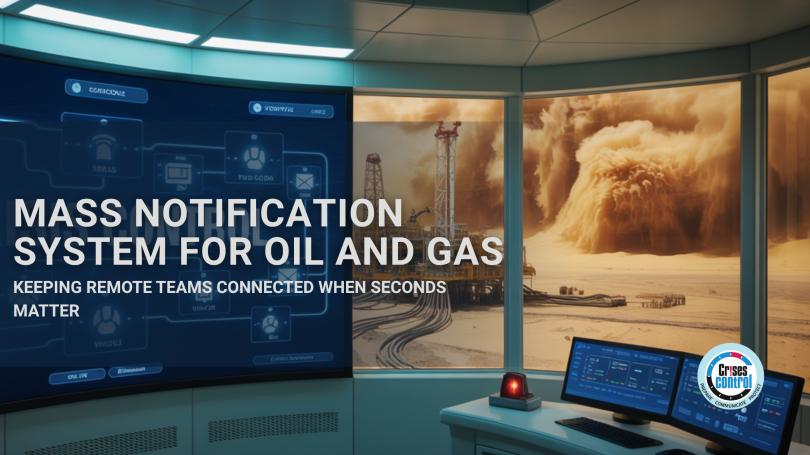Written by Chanay Blomkamp | Crises Control Marketing Assistant
Oil and gas production often happens far from towns and strong mobile coverage. Picture a drilling crew working through the night when a pump seal fails and crude sprays across the deck. The foreman must alert every worker, shut down fuel lines, and summon a standby vessel before pressure loss starts a fire. Radios reach only part of the crew and emails sit unread in inboxes. Within ten minutes the leak doubles, alarms blare, and the control room still has no proof that all twenty‑eight people have moved to safe zones.
A Mass Notification System fixes this gap by delivering the same clear instruction through several channels at once, then feeding back who has read or heard it. Crises Control adds pre‑built incident templates, location filters, and full audit trails, turning a scramble into a controlled drill. The result is faster action, less harm, and a shorter shutdown.
Why Remote Energy Sites Need Fast, Reliable Alerts
Oil and gas work is dangerous by nature. Staff handle flammable liquids, high pressures, and heavy machinery while offshore swells or sandstorms batter equipment. Medical aid, extra supplies, and specialist crews are hours away. A small lapse in communication can turn a routine fault into injury, environmental damage, or a week without production.
A cloud first Mass Notification System supplies three critical benefits:
-
- Reach: The alert travels by SMS, voice call, email, push notification, Microsoft Teams, and desktop flash.
-
- Proof: Read receipts and acknowledgements arrive in real time. Control room staff see who is clear, who is in danger, and who needs help.
-
- Clarity: Everyone receives the same vetted message, cutting rumours and confusion.
Communication Hurdles on Rigs, Pipelines, and Plants
-
- Intermittent connectivity: Offshore and desert sites share limited bandwidth. A notification platform must compress data and retry until delivery is confirmed.
-
- Shift patterns and languages: Crews swap every twelve hours, and many prefer different languages. Role‑based recipient lists and automatic translation keep messages relevant.
-
- Regulatory pressure: Organisations such as the UK Health and Safety Executive demand time‑stamped logs after incidents. Missing or altered records invite fines.
-
- High background noise: Engines, pumps, and helicopters drown out sirens. Digital channels add visual prompts that cut through the noise.
Six Features Every Mass Notification System Must Offer
1. Multi‑channel delivery with offline fallback
Crises Control fires the same alert through SMS, voice, email, mobile push, Microsoft Teams, and desktop pop‑up.
2. Geotargeting and role filters
A live map lets officers draw a safety radius or pick a pipeline segment. Only staff in that zone receive evacuation orders, which curbs alert fatigue.
3. Two‑way acknowledgement
Workers tap a single button, reply by text, or press a phone key to confirm they are safe.
4. Pre‑configured scenarios and automation
Templates for gas leaks, well control, or cyber attacks hold drafted text, phone scripts, and task lists. One click launches the whole sequence without rewriting messages during a crisis.
5. Open APIs for sensors and business systems
SCADA alarms, lone‑worker devices, and HR records feed straight into the platform. When a pressure sensor hits a red limit, an alert reaches the duty engineer before manual calls even start.
6. Compliance ready reporting
Each alert carries a digital signature and time stamp. Exportable PDF and CSV reports satisfy auditors, insurers, and management reviews without extra effort.
Case Study: Reliable Crisis Communication for LNG Operations
A leading LNG producer in the EMEA region, with over 600 staff, needed a fast, reliable way to manage critical incidents and minimise supply disruption. Operating across energy, production, and transport, the business required a solution that could notify teams instantly and keep communications flowing under pressure.
The Solution:
They deployed the Crises Control platform to send rapid, multi-channel alerts to response teams and stakeholders. Crises Control provided both remote and on-site onboarding, including live training, system setup, and scenario-based testing with 30 users.
Customer Insights:
“Crises Control has provided an additional level of assurance to us that our critical messages will get out quickly and securely when they are needed.”
— Head of Business Continuity
Ongoing support includes 24/7 helpdesk access and weekly calls with a dedicated account manager.
Interested in our Ping Mass Notification Software?
Efficiently alert everyone in seconds at scale with our Mass Notification Software – PING, get the message out fast and ensure rapid response and recovery.

Proving the Return on Investment
-
- Reduced downtime: North Sea shutdowns cost roughly seven million pounds per day. Cutting even one hour of chaos can pay three years of platform fees.
-
- Lower fines and legal risk: Clear, traceable alerts show regulators that management acted responsibly. Penalties often fall when proof is strong.
-
- Insurance discounts: Underwriters value reliable communication. Many offer premium reductions to firms that demonstrate robust alerting and audit trails.
-
- Reputation gain: Smooth, visible action reassures staff, partners, and investors. Fewer leaks to the press mean less damage to brand value.
Deployment Roadmap for Remote Sites
-
- Conduct a gap analysis: Map present communication steps for fire, spill, and medical scenarios. Identify bottlenecks and single points of failure.
-
- Clean contact data: Sync details from HR, contractor databases, and visitor logs. Update formats and remove old records.
-
- Run a pilot: Choose one rig or compressor station. Measure delivery speed, acknowledgement rate, and time to resolve. Adjust templates as you learn.
-
- Connect sensors and alarms: Use Crises Control APIs to pull critical values from gas detectors, vibration monitors, and the security operations centre.
-
- Train and exercise: Schedule quarterly drills. The platform’s simulation mode sends practice alerts without ringing every phone outside the exercise.
-
- Review and improve: After each event or exercise, export the log, hold a short debrief, and refine wording, contact lists, and escalation paths.
Ready for Safer, Faster Communication?
A Mass Notification System turns scattered teams into a coordinated unit that reacts within minutes, not hours. Crises Control pairs proven technology with oil and gas experience and full time support. The platform protects people, assets, and production without forcing a long IT build.
Ready to protect your remote crews and critical infrastructure with confidence? Book your free personalised demo with Crises Control.
Request a FREE Demo

